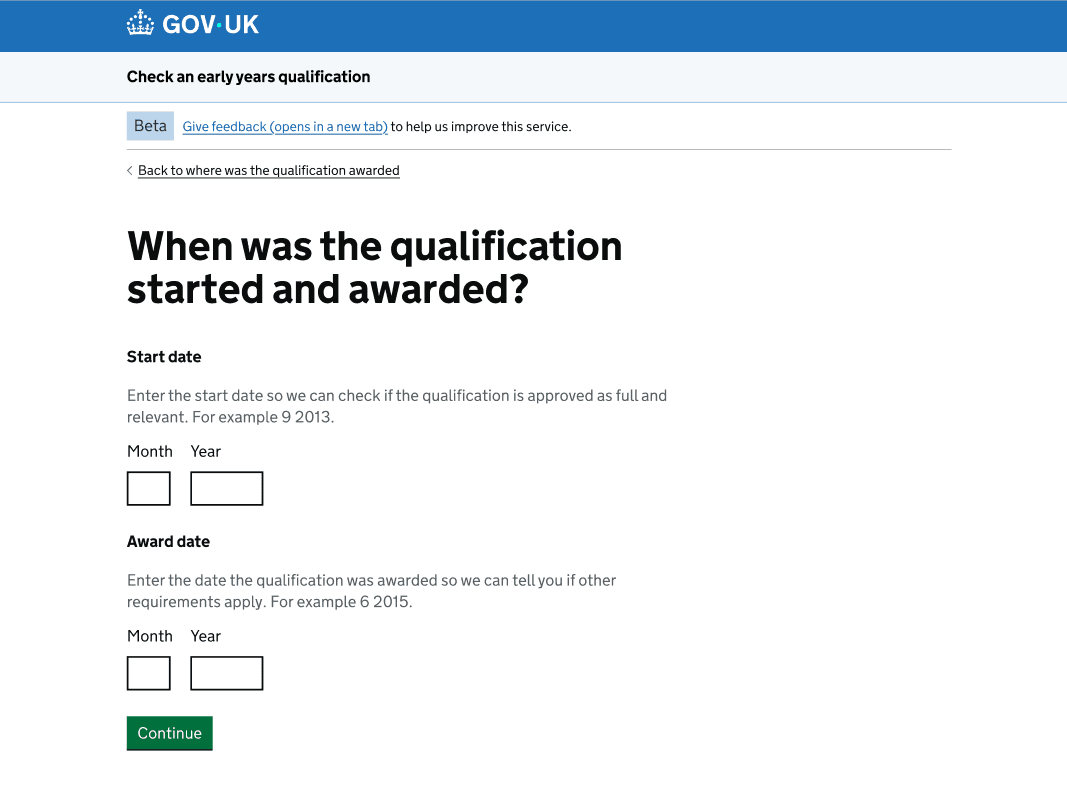The ‘Check an early years qualification’ service helps early years managers to:
- check if an early years qualification achieved in the UK is approved as full and relevant by the Department for Education (DfE)
- confirm if someone who holds this qualification can count in staff:child ratios at level 2, 3 or 6 in an early years setting in England
To do this accurately, users need to provide details about the qualification, including the start date.
The information in the digital service is identical to the early years qualifications achieved in the United Kingdom checklist (EYQL) spreadsheet. Regardless of which tool users use — the spreadsheet or the service — they should be able to reach the same outcome.
The problem
The start date is essential for determining which criteria apply when assessing a qualification. This mirrors how the EYQL spreadsheet works — the start date determines which version of the criteria should be used.
However, across multiple rounds of research, we’ve seen that users struggle to provide this information. The start date isn’t readily available, as it doesn’t appear on the qualification certificate — the document managers typically ask potential hires to provide. Certificates only show the award date.
As a result, managers often need to contact practitioners directly or reach out to awarding organisations, leading to delays in recruitment and added frustration.
We also found that many users don’t understand why the start date matters. Some assume it’s a new requirement introduced by the digital service, when in fact it’s already needed to use the existing spreadsheet correctly.
As a result of this misunderstanding, we saw users entering the award date instead of the start date, which led to inaccurate results.
What we changed
To address these issues, we made several changes to how the service asks for the start date.
We redesigned the page to make the importance of the start date clearer. Initially, we used a details component to explain why this date matters. However, research showed that users weren’t opening it and were missing key information, so we removed the component and surfaced the explanation in the main content instead.
We also revised the content to make it clear that users will only get an accurate result if they provide the correct start date.
In addition, we added a question for the award date on the same page as the start date. This helps reduce confusion and makes it less likely that users will enter the award date instead of the start date, since now they need to provide both. It also enables the service to return a more detailed outcome.

Before: Start date question only, with hint text showing the expected date format (month and year). No explanation was provided about why the start date is important.

After: Start and award date questions are shown together, with improved content explaining why each is needed. The guidance is now visible by default, not hidden in a details component.
What we learned
This work highlighted that the issue isn’t limited to the service, it reflects a wider misunderstanding of how the existing spreadsheet should be used.
We shared our research and design insights with policy and delivery colleagues. As a result, comms were planned to explain how to use the EYQL spreadsheet correctly. We also supported improvements to the spreadsheet content to make the language clearer.
This means we’ve been able to improve both the existing spreadsheet and the new service, based on what we learned through research and testing.
Next steps
We will continue to test this page in user research and monitor drop-off rates closely. This will help us understand whether:
- the homepage content clearly sets expectations about the information users need before starting the check
- the content on the page asking for the start date is clear, relevant, and easy to act on
These insights will inform further improvements to reduce confusion and ensure users are prepared to complete the journey.
